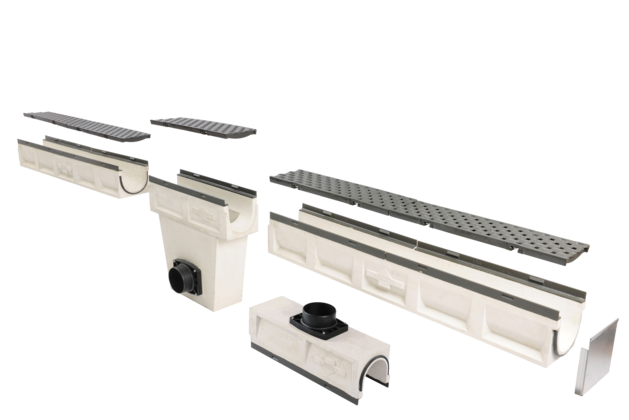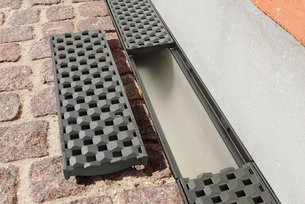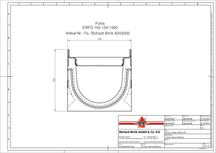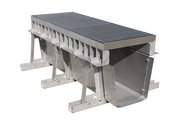Concrete channel Fortis
- dewatering channel for linear drainage under heavy-duty conditions
- choice of steel, stainless steel or cast iron frame
- watertight, high-strength and chemically resistant material
- highly leak-tight surface structure
- relatively low weight
- tongue and groove system with integrated rubber seal
- compatible heavy-duty mesh and longitudinal bar gratings; matching cast gratings available for cast frames
Available in shop
Standard sizes available in 2 to 3 business days
An enormous amount of force acts on areas exposed to particularly high wheel loads – due to lorry traffic, for example. The installed dewatering systems have to be able to cope with this at all times, which is why DIN 1433 “Drainage channels for vehicular and pedestrian areas” specifies load classes. Our “Fortis” concrete channel is designed for classes A 15 to E 600 and can therefore be relied upon to withstand loads of up to 60 tons. The heavy-duty dewatering channel is used, among other things, in driveways, roads, courtyard surfaces in front of buildings and parking areas, where it ensures reliable linear drainage. Rainfall can flow over concrete inlets that feature run-off pipes. A direct connection to a shaft or existing channel is also feasible.
The channel’s appropriately dimensioned concrete framing comprising base and edge restraints ensures load transfer. The channel body is made of high-strength, waterproof concrete made by Richard Brink. It has wall and floor thicknesses of 20mm. The chosen concrete matrix guarantees wear resistance to various chemical influences while the leak-proof surface structure enables rain water to run straight off. The moulded frame is available either in stainless steel, hot-dip galvanised steel or cast iron.
The low weight of the concrete channel benefits transportation on the one hand and straightforward installation on the other. It can be mounted by one person without the need for extra equipment or lifting tools. When installed, the channels have to remain 2 to 3mm under the road surface. Cassette-shaped cut-out sections on the outer sides prevent the channel from floating up and make sure that the concrete base can form a firm connection with it. A tongue-and-groove system with integrated rubber seals on the ends of the channel does away with the need for complex sealing work along the joints.
Concrete channel Fortis |
|
|---|---|
|
Widths (nominal widths): |
155 mm (DN 100) 206 mm (DN 150)* *DN 150 only available in height 200 mm |
|
Load class: |
D 400 |
|
Lengths |
500 mm 1.000 mm |
|
Heights |
80 mm 150 mm 175 mm 200 mm* |
|
Material |
Fibre-modified concrete |
|
Frames depending on the grate layer optionally made of: |
hot-dip galvanised steel stainless steel cast iron |
|
Accessories |
End pieces Sink boxes incl. dirt trap made of V2A Gutters with integrated connection pieces |



Stutzen Stücke



Customers also bought
+ More from the categoryOur „Fortis“ in action
Transforming the functional into something beautiful
Richard Brink supplies concrete channels and cast gratings for new residential areas in Copenhagen’s South Harbour
Copenhagen, 13.09.2023. Urban redensification and the development of abandoned industrial, rail and harbour installations have long been a focus of urban development. The modern residential quarters that have emerged on Copenhagen’s South Harbour…
Read moreDry feet throughout the city centre
Richard Brink products provide drainage for a timelessly modern pedestrian zone
The city of Pforzheim wanted to revamp Westliche Karl-Friedrich-Strasse, transforming it into a modern, spacious and inviting pedestrian zone. To that end, an area measuring around 200 m in length was paved with high-quality concrete tiling, and…
Read more
























